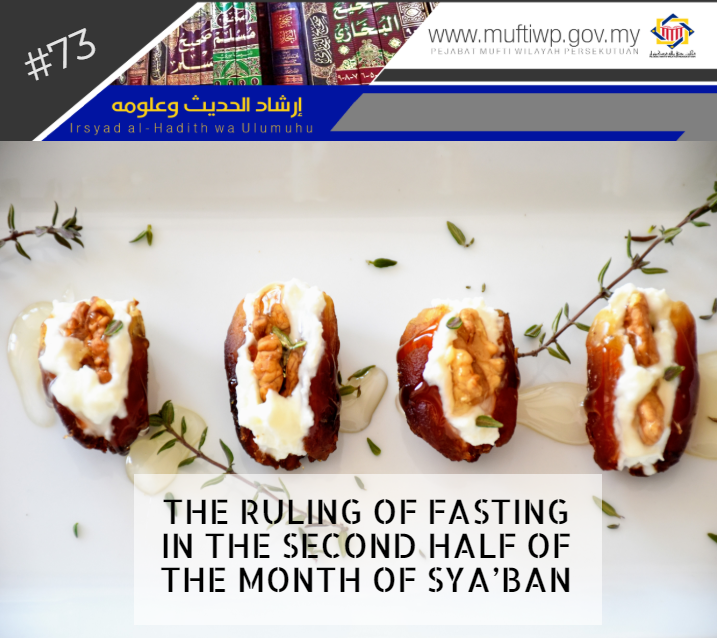Question:
Is it permissible to fast after fifteen days of Sya’ban have passed?
Answer:
Waalaikumussalam wrt, wbt.,
Alhamdulillah, praise and thanks to Allah for the countless blessings He has blessed us all with. Blessings and salutations to the Prophet Muhammad PBUH, his wives, his family, companions and all those that follow his teachings to the day of judgement.
Regarding the issue that is going to be discussed today, it is an important issue that always came up when we are nearing the month of Ramadhan. Thus, in this series of Irsyad al-Hadith we will discuss the issue of fasting in the last two weeks of Sya’ban.
Matan Hadith
- From Abu Hurairah RA, the Prophet PBUH said:
إِذَا انْتَصَفَ شَعْبَانُ فَلَا تَصُوْمُوْا
"When it is the middle of Sha'ban do not fast.”
- In another narration:
إِذَا كَانَ النِّصْفُ مِنْ شَعْبَانَ فَلاَ صَوْمَ حَتَّى يَجِىءَ رَمَضَانُ
"When it is the middle of Sha'ban do not fast (until it is Ramadan).”
- In another narration:
إِذَا كَانَ النِّصْفُ مِنْ شَعْبَانَ، فَأَفْطِرُوا حَتَّى يَجِيءَ رَمَضَانُ
When it is the middle of Sha’ban, eat until Ramadan comes.
- In yet another narration:
إِذَا كَانَ النِّصْفُ مِنْ شَعْبَانَ فَأَمْسِكُوا عَنِ الصَّوْمِ حَتَّى يَكُونَ رَمَضَانُ
"When a half of Sha'ban remains then hold yourself from fasting until Ramadhan comes."
Takhrij al-Hadith
This hadith is stated by Imam Ahmad (2/442), Abu Daud (2337), al-Nasaie (2923), al-Tirmizi (738), Ibn Majah (1651), al-Darimiy (1691) and many more. Although the wordings are all different, they all have the same meaning.
The Status of the Hadith
There are differences of opinions among scholars regarding the status of this hadith. Some of them said it is sahih while others evaluated it as dhaif (weak).
First opinion: Among the scholars who evaluated the hadith as sahih are:
- Imam al-Tirmizi: The hadith is hasan sahih. [See: Jami’ al-Tirmizi, no. Hadith 669]
- Imam Ibn Hibban: The hadith is sahih. [See: Sahih Ibn Hibban, no. Hadith 3589]
- Imam Ibn Abd al-Bar: The hadith is sahih. [See: al-Istizkar, 10/239]
- Ahmad Syakir: The hadith is sahih. [See: Ta’liq ‘ala Tahzib al-Sunan, 3/225]
Second opinion: Among the scholars who ruled the hadith as dhaif:
- Imam Ahmad: The hadith is munkar. [See: Lathaif al-Ma’arif, 135]
- Al-Athram: The hadith is munkar. [See: Lathaif al-Ma’arif, 135]
- Abdulrahman bin Mahdi: The hadith is munkar. [See: Lathaif al-Ma’arif, 135]
- Abu Zur’ah: This is a munkar hadith. [See: Lathaif al-Ma’arif, 135]
Tarjih (Disposition)
According to the opinions of scholars regarding the status of this hadith, thus, we are inclined to state that the hadith is dhaif although it is stated as sahih by some of the scholars. Among the reasons we are inclined to say this are due to several factors:
- First: al-‘Ala’ is alone in the narration of this hadith. Thus, this hadith is gharib according to the opinion of Imam al-Nasaie “we don’t know another narrator who narrates this hadith except from al-‘Ala bin Abdulrahman”. Furthermore, in Imam al-Tirmizi’s opinion, he stated: “we do not know any other path of this narration apart from this path”.
- Second: This hadith contradicts with another sahih narration by Abu Hurairah RA, where the Prophet PBUH said:
لاَ تَقَدَّمُوا رَمَضَانَ بِصَوْمِ يَوْمٍ وَلاَ يَوْمَيْنِ
"None of you should precede Ramadhan with a day or two of fasting before the (beginning of the) month of Ramadan,”
Sahih Muslim (1812)
However, we are also of the opinion that it is permissible for whoever who wants to fast after the middle of Sya’ban if he is someone who always performs sunnah fasting such as fasting on Mondays and Thursdays. The same applies to those who always fast on white days (أيام البيض) and those who practise the fast of the Prophet David AS. This is the opinion of the majority of scholars in this issue.
The Meaning of “فَلَا تَصُوْمُوْا”
The restriction stated in the hadith is for those who don’t usually perform sunnah fasting. As for anyone who has always fasted, then it is not an issue for him to fast during the stated time. (See Fath al-Bari, 4/215)
The Opinions of Scholars on the Issue of Fasting After the Middle of Sya’ban
The following are the opinions of scholars on this matter:
- Madhhab al-Syafie: Fasting after the middle of Sya’ban is haram or makruh for those who don’t usually fast and if it is not preceded or followed by another day of fasting. In other words, a person who fast only in the stated duration of time. (See al-Mu’tamad, 2/216)
- The majority of scholars (jumhur): It is permissible to fast after the 15th of Sya’ban.
The Wisdom Behind the Impermissibility of Fasting
Furthermore, if we consider and hold onto the opinion that the hadith is sahih as stated by some of the scholars, then there are wisdom as to why it is impermissible to fast during this time. Among the wisdom is so that the Muslim ummah can prepare themselves before facing the month of Ramadhan, where in this month every mukallaf Muslim is obligated to fast for a whole month.
Conclusion
To conclude, we would like to reaffirm that it is permissible to fast after the 15th of Sya’ban for the hadith which restricts it is weak and contradicts a sahih hadith. Especially if a woman wants to fast to replace her Ramadhan fast the preceding year, then it is a commandment. The reason is Saidatina Aisyah R.Anha herself replaces her Ramadhan fast in the month of Sya’ban. Lastly, may Allah SWT grant us the strength and time to perform our worships to its perfection. Amin.


